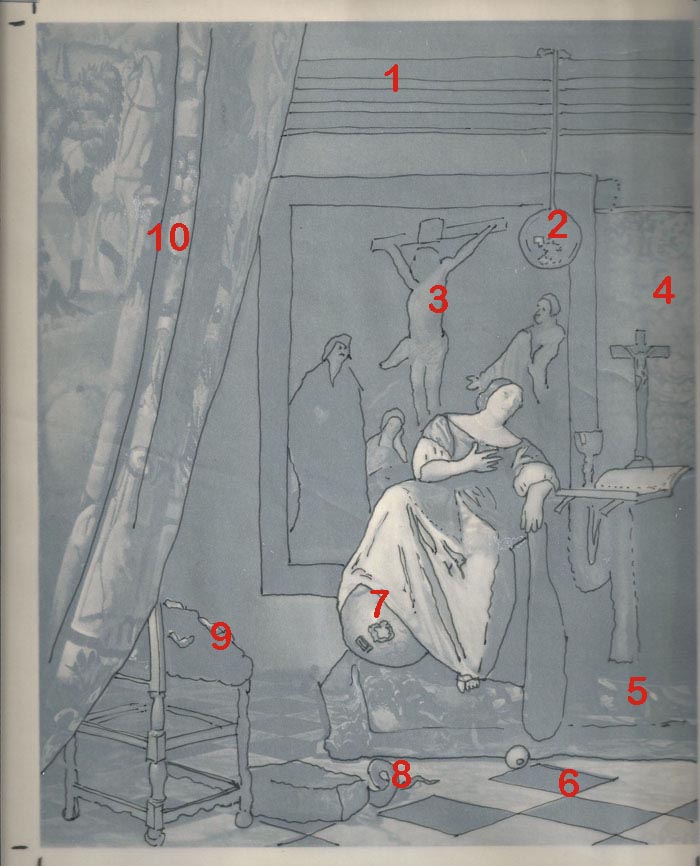 ..
..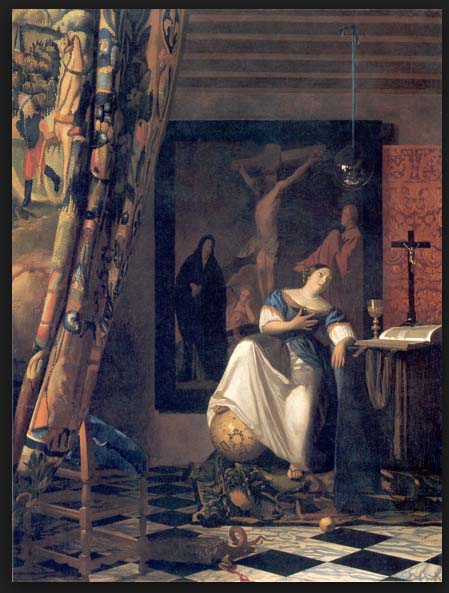
 ..
..
Preview of an upcoming 40.000 word book:
Velasquez-Pareja-restoration booklet, MMA, NYC.
Caption: Johannes Vermeer, Allegory of Catholic Faith, Metropolitan Museum of Art, New York City. c. 1670- 1674 Oil on canvas 114.3 x 88.9 cm. (45 x 35 in.). To the left: Scheme drawing by Kaldenbach. To the right: the actual Vermeer painting.
We see a female figure, her hand on heart, seated on a raised dais, with many unfamiliar objects all around her. Obviously this is not a standard view of a regular female in a Dutch interior. The painting shows Catholicism triumphant. The Metropolitan Museum of Art is using the full title Allegory of the Catholic Faith.
In fine art, an allegory points at an elevated idea, and uses an extended comparison, a stack of related symbolic elements. The source book of these elements shown here is Cesare Ripa: Iconologia, published in Dutch in 1644.
Some critics have described this painting as slick, over the top and painful to look at. The MMA web site states that in this “atypical painting the artist employed a more abstractive style to suit the intellectual subject.” Today it strangeness certainly invites readers of this start a point by point comparison with The Art of Painting, Vienna, which looks hyper-real and stunning even now, in our age of digital photography.
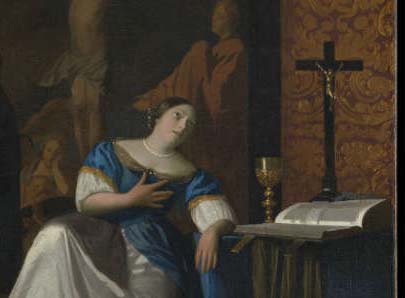 Detail with a table functioning as an altar table. On the altar table a cloth, a standing crucifix, a gilded chalice and a hefty liturgical tome used during Roman Catholic Mass, the Missale Romanum. These items are necessary for the Eucharist: changing bread and wine into the body and blood of Christ, to be received in Holy communion by the faithful.
Detail with a table functioning as an altar table. On the altar table a cloth, a standing crucifix, a gilded chalice and a hefty liturgical tome used during Roman Catholic Mass, the Missale Romanum. These items are necessary for the Eucharist: changing bread and wine into the body and blood of Christ, to be received in Holy communion by the faithful.
The scene looks like a set-up normally used in a hidden church, located in a private house, its function being more or less condoned by the Dutch city authorities who were Dutch Reformed since the 1570’s power takeover.
Such a hidden church was operated by the Jesuits a few houses down from Vermeer’s Oude Langendijk house. The list of Vermeer’s children’s Christian names proves conclusively that the family was actively Roman Catholic.
 ..
..
1.
Series of strong wooden beams stretch from sidewall to sidewall in this room, carrying the floorboards above set at an angle of 90 degrees. These floor boards double as a ceiling of this room.
2
A large mirrored glass sphere is reflecting the whole room. The sphere is hanging on a blue ribbon suspended from the ceiling. It is contrasted with the earthly globe below. Reflected in the glass are three light sources on the left hand side. The middle one shows light coming in from a crossbeam window with the lower left part shuttered. The rest of the reflections on it of the room below are more or less abstract. The glass object also invites speculation about religious faith.
3
In the back of this room we see a large painting-within-a-painting, a Crucificion by Jacob Jordaens, Cologne, Wallraf-Richartz-Museum. A copy is mentioned in the inventory of movable goods in the Vermeer home. Vermeer chose to subdue the brilliant colours to a muted grey-brown in order to focus attention on Lady Faith.

CAPTION: Jacob Jordaens, Crucificion, Cologne, Wallraf-Richartz-Museum. A copy was in Vermeer’s personal art collection.
 4
4
A strip of gold-tooled leather. The Vermeer family owned it, as can be noted in the 1976 inventory. The strip is also included by Vermeer in The Love Letter, Rijksmuseum. This type of leather was embossed under heat, moisture and pressure, then covered by a thin layer of glue and silver foil and subsequently varnished, giving it a golden sheen. This type of wall covering was considered the ultimate upper class luxury. In front three objects for saying mass, the chalice, crucifix and a mass book, the Missale Romanum.
5
An expensive rug covering the dais. Rugs were usually preserved as wall hangings or table rugs.
6
Stretched in front is an extremely costly Italian marble floor. This type of floor was a product of Vermeer’s fertile visual imagination. Such a floor existed only in the front hall of the Town Hall on Market square, not in private Delft houses of that period.
7
The foot of lady Faith is resting on a terrestrial globe dating from 1618, all according to Ripa’s handbook. Probably by the Amsterdam firm of Blaeu.
8
On the floor a dead snake, blood seeping from its body, having been crushed by a big slab of stone.
A bit towards the back is an apple, famed from Original Sin, the Adam and Eve story.
9
A chair with a blue cushion is forming a visual rhyme with the blue dress of lady Faith. Chairs such as this one are mentioned in the inventory of 1676 and often appear in Vermeer paintings.
10
An extremely costly hanging tapestry with human figures on it, pulled left to reveal the scene. According to the museum it is a Flemish tapestry.
The strength of Vermeer always lies in representing a very credible, almost lifelike high-definition view of a light-filled space in which everything seems real or where at least the viewer is invited to enjoy suspension of disbelief.
Jesuits were the advisors of the rich Roman Catholic patron in Delft who put down a large sum for The Allegory of Catholic Faith and of Vermeer. These Jesuits may or may not have proscribed the contents, largely based upon the exact recipe in the 1644 Dutch issue by Pers, of Ripa’s Iconologia book. In it a woman, representing Faith, sits with her foot on a globe (the world in submission), with a crushed and bleeding snake under a stone (evil overcome). She sits raised on a pedestal-platform (being dominant) covered by an expensive tapestry.
Tapestries, as can be seen in most Vermeer paintings were to be hung or put on a table, but not to be walked upon. To the left hangs one of the grand, extremely expensive tapestries for which the Delft Spierinx workshop was so famous, and 40 staff were put to work there. The crucifix, chalice and missal book to the right define it as a Roman Catholic scene. The painting of a crucifixion by Jordaens in the background is huge in size, more suitable for a Roman Catholic church than for a private home. Hanging from a ribbon is a single thin glass sphere reflecting the whole scene.
 None of these many elements is very credible in a Dutch interior. The painting design therefore suffers from a broken tension between PR for faith-driven religion and the required suspension of disbelief in a scene, which wants to deceive the eye. Some of the elements shown are almost ludicrous. A saving grace of the Allegory of Catholic Faith is the artist’s excellent painting technique. The strip of gold-tooled leather (actually the leather was silvered then covered with yellow varnish on top) reproduced in this painting was owned by the artist, and can also be seen in in his painting The Love Letter, Rijksmuseum, Amsterdam (see Chapter 4).
None of these many elements is very credible in a Dutch interior. The painting design therefore suffers from a broken tension between PR for faith-driven religion and the required suspension of disbelief in a scene, which wants to deceive the eye. Some of the elements shown are almost ludicrous. A saving grace of the Allegory of Catholic Faith is the artist’s excellent painting technique. The strip of gold-tooled leather (actually the leather was silvered then covered with yellow varnish on top) reproduced in this painting was owned by the artist, and can also be seen in in his painting The Love Letter, Rijksmuseum, Amsterdam (see Chapter 4).
Abridged provenance: Allegory of the Catholic Faith was probably ordered by a private person to be placed in the Jesuit hidden church a few housed down.
Since, this painting has had many owners in the course of four centuries, in 1899 Abraham Bredius, the director if the Mauritshuis museum bought it privately but in 1928 he sold it to Friedsam who donated it in 1931.
For many Vermeer fans, this is a bothersome painting. The painter’s neighbours several doors down on the Oude Langendijk canal were the local Jesuit priests. They manned a hidden church in which the interests of the pope and the Roman Catholic Church were furthered. For the embellishment of their interior they perhaps spoke to Vermeer (who had converted to Catholicism) and to a wealthy Delft patron, whose name we do not know, who probably paid for The Allegory of Catholic Faith. It was supposed to mirror the excellence of the The Art of Painting.
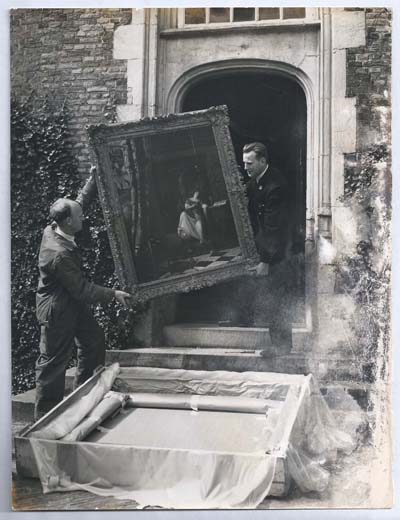
CAPTION: Vintage photograph, taken 26 May 1952 by the Delft photographer P. van der Reijken. Here the Vermeer painting The Allegory of Catholic Faith is being unwrapped at the Prinsenhof Museum in Delft. The box was opened outside in broad daylight, where birds could have landed their droppings. Standards of art shipping and art handling have changed since this cavalier event.
The painting was transported to Delft for the Prinsenhof Museum exhibition "Prisma der bijbelse kunst" but the painting arrived one week too late for the exhibition, as it had already opened on 17 May 1952. Author’s collection.
See Dali's opinion of Vermeer
Vermeer and Neuroscience / Opthalmology.
Adriaen Coorte, by Quentin Buvelot, book & exhibition catalogue.
De Grote Rembrandt, door Gary Schwartz, boek.
Geschiedenis van Alkmaar, boek.
Carel Fabritius, Tentoonstellingscatalogus.
Frans van Mieris, Tentoonstellingscatalogus.
From Rembrandt to Vermeer, Grove Art catalogue, book.
Vermeer Studies, Congresbundel.
C. Willemijn Fock: Het Nederlandse interieur in beeld, boek.
Het Huwelijksgeschenk (1934), boek over de egoïstische vrouw, die haar luiheid botviert.
Zandvliet, 250 De Rijksten van de Gouden Eeuw , boek + nieuwe stippenplattegrond!
Ik doe wat ik doe, teksten van Lennaert Nijgh , boek + cd
Het Rotterdam Boek, boek.
Bouwen in Nederland 600 - 2000, boek.
Hollandse Stadsgezichten/ Dutch Cityscape, exhib. cat.
Zee van Land / over Hollandse Polders (NL) boek
Sea of Land / about Dutch Polders (English) book
A full article on the large portrait of the marvellous preacher Uytenboogaard.
Artikel over Uytenboogaerd, Nederlandse versie.
Geert Grote en het religieuze Andachtsbild

How to find Drs Kaldenbach:
Map of Haarlemmermeerstraat, Amsterdam. Please note this tricky situation: there is another street in town that sounds almost the same: Haarlemmerstraat. You need however to find my street, Haarlemmermeerstraat. Take tram 2 to Hoofddorpplein square or tram 1 to Suriname plein square.
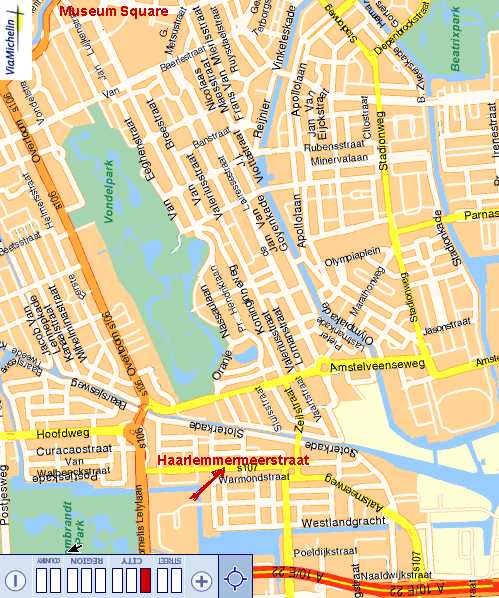
Contact information:
Drs. Kees Kaldenbach , kalden@xs4all.nl
Haarlemmermeerstraat 83 hs
1058 JS Amsterdam
The Netherlands
telephone 020 - 669 8119
(from abroad NL +20 - 669 8119)
cell phone 06 - 2868 9775
(from abroad NL +6 - 2868 9775)
How to get there (after your booking confirmation!):
- by car: ring road exit S 106 towards the centre, then 1st to the right (paid parking)
- by trams 1 and 17; exit at Surinameplein
- by tram 2; exit Hoofddorpplein.
From the museum square it takes about a 10-minute tram ride.
Read client testimonials. Read a biography.
 Menu
of tours
Menu
of tours
Photo by Dick Martin.
Reaction, questions? Read client testimonials.
Drs. Kees Kaldenbach, art historian, kalden@xs4all.nl Haarlemmermeerstraat 83hs, 1058 JS Amsterdam (near Surinameplein, ring road exit s106, streetcar tram 1 and 17).
Telephone 020 669 8119; cell phone 06 - 2868 9775.
Open seven days a week.
Member of Amsterdam Chamber of Commerce (Kamer van Koophandel)
E mail esponses and bookings to art historian Drs. Kees Kaldenbach.
This page forms part of the 2000+ item Vermeer web site at www.xs4all.nl/~kalden
Launched October 24, 2007. Updated 15 February 2017.